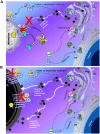Specific interaction of Gαi3 with the Oa1 G-protein coupled receptor controls the size and density of melanosomes in retinal pigment epithelium
- PMID: 21931697
- PMCID: PMC3169599
- DOI: 10.1371/journal.pone.0024376
Specific interaction of Gαi3 with the Oa1 G-protein coupled receptor controls the size and density of melanosomes in retinal pigment epithelium
Abstract
Background: Ocular albinism type 1, an X-linked disease characterized by the presence of enlarged melanosomes in the retinal pigment epithelium (RPE) and abnormal crossing of axons at the optic chiasm, is caused by mutations in the OA1 gene. The protein product of this gene is a G-protein-coupled receptor (GPCR) localized in RPE melanosomes. The Oa1-/- mouse model of ocular albinism reproduces the human disease. Oa1 has been shown to immunoprecipitate with the Gαi subunit of heterotrimeric G proteins from human skin melanocytes. However, the Gαi subfamily has three highly homologous members, Gαi1, Gαi2 and Gαi3 and it is possible that one or more of them partners with Oa1. We had previously shown by in-vivo studies that Gαi3-/- and Oa1-/- mice have similar RPE phenotype and decussation patterns. In this paper we analyze the specificity of the Oa1-Gαi interaction.
Methodology: By using the genetic mouse models Gαi1-/-, Gαi2-/-, Gαi3-/- and the double knockout Gαi1-/-, Gαi3-/- that lack functional Gαi1, Gαi2, Gαi3, or both Gαi1 and Gαi3 proteins, respectively, we show that Gαi3 is critical for the maintenance of a normal melanosomal phenotype and that its absence is associated with changes in melanosomal size and density. GST-pull-down and immunoprecipitation assays conclusively demonstrate that Gαi3 is the only Gαi that binds to Oa1. Western blots show that Gαi3 expression is barely detectable in the Oa1-/- RPE, strongly supporting a previously unsuspected role for Gαi3 in melanosomal biogenesis.
Conclusion: Our results identify the Oa1 transducer Gαi3 as the first downstream component in the Oa1 signaling pathway.
Conflict of interest statement
Figures








Similar articles
-
A constitutively active Gαi3 protein corrects the abnormal retinal pigment epithelium phenotype of Oa1-/- mice.PLoS One. 2013 Sep 30;8(9):e76240. doi: 10.1371/journal.pone.0076240. eCollection 2013. PLoS One. 2013. PMID: 24098784 Free PMC article.
-
Involvement of OA1, an intracellular GPCR, and G alpha i3, its binding protein, in melanosomal biogenesis and optic pathway formation.Invest Ophthalmol Vis Sci. 2008 Jul;49(7):3245-52. doi: 10.1167/iovs.08-1806. Epub 2008 Mar 31. Invest Ophthalmol Vis Sci. 2008. PMID: 18378571 Free PMC article.
-
The ocular albinism type 1 protein, an intracellular G protein-coupled receptor, regulates melanosome transport in pigment cells.Hum Mol Genet. 2008 Nov 15;17(22):3487-501. doi: 10.1093/hmg/ddn241. Epub 2008 Aug 12. Hum Mol Genet. 2008. PMID: 18697795 Free PMC article.
-
The ocular albinism type 1 (OA1) protein and the evidence for an intracellular signal transduction system involved in melanosome biogenesis.Pigment Cell Res. 2005 Aug;18(4):227-33. doi: 10.1111/j.1600-0749.2005.00240.x. Pigment Cell Res. 2005. PMID: 16029416 Review.
-
Ocular albinism type 1: more than meets the eye.Pigment Cell Res. 2001 Aug;14(4):243-8. doi: 10.1034/j.1600-0749.2001.140403.x. Pigment Cell Res. 2001. PMID: 11549106 Review.
Cited by
-
Decreased CREB phosphorylation impairs embryonic retinal neurogenesis in the Oa1-/- mouse model of Ocular albinism.bioRxiv [Preprint]. 2024 May 14:2024.05.14.594013. doi: 10.1101/2024.05.14.594013. bioRxiv. 2024. PMID: 38798688 Free PMC article. Preprint.
-
GNAI3: Another Candidate Gene to Screen in Persons with Ocular Albinism.PLoS One. 2016 Sep 8;11(9):e0162273. doi: 10.1371/journal.pone.0162273. eCollection 2016. PLoS One. 2016. PMID: 27607449 Free PMC article.
-
Location-dependent signaling of the group 1 metabotropic glutamate receptor mGlu5.Mol Pharmacol. 2014 Dec;86(6):774-85. doi: 10.1124/mol.114.094763. Epub 2014 Oct 17. Mol Pharmacol. 2014. PMID: 25326002 Free PMC article. Review.
-
Ocular Albinism Type 1 Regulates Deltamethrin Tolerance in Lymantria dispar and Drosophila melanogaster.Front Physiol. 2019 Jun 19;10:766. doi: 10.3389/fphys.2019.00766. eCollection 2019. Front Physiol. 2019. PMID: 31275171 Free PMC article.
-
Conversations with Ray Guillery on albinism: linking Siamese cat visual pathway connectivity to mouse retinal development.Eur J Neurosci. 2019 Apr;49(7):913-927. doi: 10.1111/ejn.14396. Epub 2019 Apr 23. Eur J Neurosci. 2019. PMID: 30801828 Free PMC article. Review.
References
-
- King RC, Stansfield WD, Mulligan PK. A Dictionary of Genetics, Seventh Edition. Oxford University Press; 2006.
-
- Oetting WS, Summers CG, King RA. Albinism and the associated ocular defects. Metab Pediatr Syst Ophthalmol. 1994;17:5–9. - PubMed
-
- Garner A, Jay BS. Macromelanosomes in X-linked ocular albinism. Histopathology. 1980;4:243–54. - PubMed
-
- O'Donnell FE, Jr, Hambrick GW, Jr, Green WR, Iliff WJ, Stone DL. X-linked ocular albinism: An oculocutaneous macromelanosomal disorder. Arch Ophthalmol. 1976;94:1883–92. - PubMed
-
- Schiaffino MV, Tacchetti C. The ocular albinism type 1 (OA1) protein and the evidence for an intracellular signal transduction system involved in melanosome biogenesis. Pigment Cell Res. 2005;18:227–33. - PubMed
Publication types
MeSH terms
Substances
Grants and funding
LinkOut - more resources
Full Text Sources
Molecular Biology Databases
Research Materials
Miscellaneous

